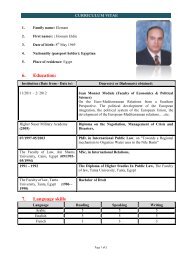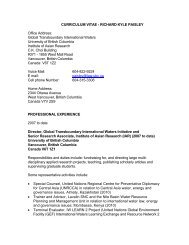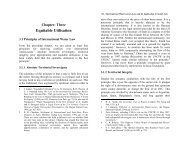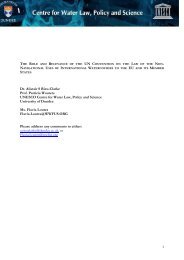Upreti, Trilochan, International Watercourses Law and Its Application ...
Upreti, Trilochan, International Watercourses Law and Its Application ...
Upreti, Trilochan, International Watercourses Law and Its Application ...
Create successful ePaper yourself
Turn your PDF publications into a flip-book with our unique Google optimized e-Paper software.
80 / <strong>International</strong> <strong>Watercourses</strong> <strong>Law</strong> <strong>and</strong> <strong>Its</strong> <strong>Application</strong> in South Asia Development <strong>and</strong> Codification of <strong>International</strong> <strong>Watercourses</strong> <strong>Law</strong> / 81itself a complicated task for the committee. 160 To fulfil itsassignment, the ILA undertook several conferences viz.,Dubrovnik 1956, New York 1958, Tokyo 1964 <strong>and</strong> finallyHelsinki 1966, where the rules were adopted. During theendeavour, lively discussions were held amongst the membersof the committee on issues ranging from downstream <strong>and</strong>upstream benefits, issues of equitable utilisation <strong>and</strong> issues ofexisting <strong>and</strong> future uses including other aspects of allocation ofwater <strong>and</strong> sharing of benefits therefrom. Eventually, theHelsinki Rules 1966 adopted the single basin approach alongwith the main principle of equitable utilisation. 161 The drainagebasin approach constituted the primary consensus among thecommittee members at the very outset of the work, which hasbeen defined in Article II. 162The principles of equitable utilisation became the core lawthough there was strong opposition from several scholars <strong>and</strong>the basis of their criticism was 'the ideas regarding the conceptof equitable sharing are not clear <strong>and</strong> states must be free todevelop their uses in accordance with their needs.’ 163 The lackof a precise definition of equitable utilisation is also a reasonfor criticism. Nonetheless, the ILA contribution is quoted inmany treaties 164 , state practices <strong>and</strong> judicial decisions. 165 It isalso regarded as the foundation of the 1997 UNCIW. 1662. 9. 2 <strong>International</strong> <strong>Law</strong> CommissionThe idea of developing international law through therestatement of existing rules or formulation of new rules is notof recent origin. On 22 September 1924, the resolution of the160 Supra note 8, pp. 233-35.161 Ibid. pp. 236 & 249.162 YBILA (1966), pp. 484.163 Supra note 8, p. 281.164 Mekong treaty in 34 ILM, (1995), pp. 864 880.165 Supra note 22, pp. 280, 319-20.166 YBILC (1982), p. 82, YBILC (1983) p. 130.Assembly of the League of Nations created a st<strong>and</strong>ing organcalled the Committee of Experts for the progressivecodification of international law, which consisted of seventeenmembers. 167 The institution continued even after theestablishment of the United Nations. Article 13 of the Charterof the United Nations provides that:“The General Assembly shall initiate studies <strong>and</strong>make recommendations for the purpose of:a. … encouraging the progressive development ofinternational law <strong>and</strong> its codification” 168Thus, the ILC was established by the United Nations GeneralAssembly (UNGA) in 1947 169 in order to promote theprogressive development of international law <strong>and</strong> itscodification. 34 members were elected by UNGA for a fiveyears term in an individual capacity (not as staterepresentatives). 170The UNGA Resolution 2669 (XXV) of December 8, 1970recommended to the ILC to initiate works on UNCIW. Aftersustained hard work for about twenty- five years, the ILCfinally adopted the said rules in 1994 in its forty-sixth session<strong>and</strong> submitted them to the UNGA. From that time,deliberations were made by its different members, <strong>and</strong> 5Special Rapporteurs. 171 As a result of the profoundcontributions made by well-known scholars on the subject <strong>and</strong>the intense efforts of the international community, the UNConvention on Non-Navigational Uses of <strong>International</strong>167 www.un.org/law/ilc/introfra.htm168 Supra note 54, p. 1052.169 S. C. McCaffrey, "Background <strong>and</strong> Overview of the <strong>International</strong> <strong>Law</strong>Commission's Study of the Non-Navigational Uses of <strong>International</strong><strong>Watercourses</strong>" (1992) in 3 CJIEL & P, p. 18.170 II YBILC (1994), p. 15.171 Richard Kinary, Stephen Schbell, Evansen, Stephan C. McCaffrey <strong>and</strong>Rosentok.












